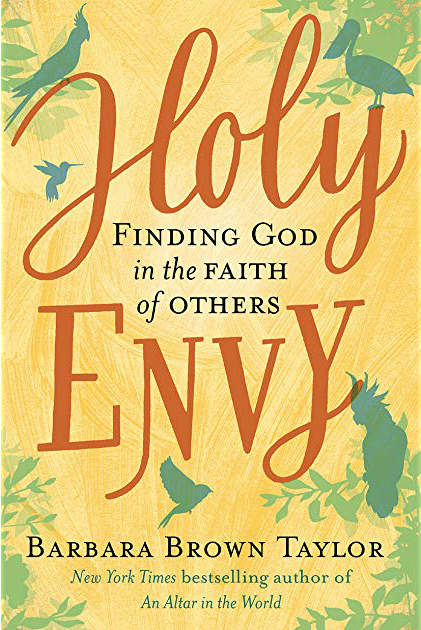Book Review
HOLY ENVY: FINDING GOD IN THE FAITH OF OTHERS. (2019).
BY BARBARA BROWN TAYLOR. NEW YORK, NY: HARPERONE.
The following by Michael Gellert consists of selections from a larger, forthcoming review that will appear in Psychological Perspectives: A Quarterly Journal of Jungian Thought, Vol. 62, Issue 2.

Barbara Brown Taylor’s remarkable new book, Holy Envy (is) an engrossing, delightful memoir about Taylor’s experience teaching Religion 101 and what it has taught her. (I)t is a must-read for anyone involved in the transmission of religious knowledge, be they a teacher, clergy member, psychotherapist, or pastoral counselor.
However, laypersons with a religious bent will also surely find it rewarding, as it is clearly a book for everyone and not just for the specialist. It is not per se an in-depth, scholarly treatment of the world’s religions (for example, like Huston Smith’s classic, The Religions of Man), but rather a colorful, engaging exploration of how different traditions and people deal with the powerful feelings and ideas that inspire our religious curiosity and influence our relationship to things divine (in this respect it is more in the vein of William James’s The Varieties of Religious Experience). The book furthermore speaks to urgent concerns of our day, concerns that comparative religion as a practical discipline might be able to uniquely address. At a time when Americans and the world at large are struggling with tolerating and learning to live with the “other” in our highly interdependent global village, Holy Envy cultivates a distinct sense of what Buddha called “right understanding” and “right attitude,” not to mention a greater inclination toward the lovingkindness that all religions preach. In short, it is a timely and important book.
For those readers unfamiliar with her, a few words about Professor Taylor herself: She wasn’t always a professor. A graduate of Yale Divinity School, she was ordained as an Episcopal priest in 1983 and served in this capacity at a couple of churches in Georgia until 1998, when she became a professor at Piedmont College in the same state. A widely celebrated Christian preacher, Taylor is the author of fourteen books, including the New York Times bestsellers Leaving Church: A Memoir of Faith (2006), An Altar in the World: A Geography of Faith (2009), and Learning to Walk in the Dark (2014). The latter of these garnered a cover story in Time magazine, who also designated her in 2014 as one of the 100 most influential people in the world. All this, of course, reflects the outer dimension of her work. Regarding the inner dimension, her books—particularly the above-mentioned ones that are written in an intimate, memoir style—reveal her to be on a passionate quest for self-knowledge wed to an ever-deepening encounter with God. Seeking to discover herself in God and God in herself, she is unquestionably on a spiritual journey and a path of individuation.
…
But only on its surface is the book the story of Taylor’s experience teaching Religion 101 to undergraduate students, some of whom, to be sure, were devout Christian fundamentalists. Underneath, it is, again, the story of her journey as a student passionately exploring five major world religions—Hinduism, Buddhism, Judaism, Islam, and Christianity. As she turns to examining the latter, the reader gets a privileged peek into what can unexpectedly happen to an open-minded Christian when she has been exposed to how other traditions portray the encounter with the divine—in particular, what can happen to her sense of containment when her own traditional container is no longer limited by its contents. Taylor’s search for a deeper, more authentic Christianity than the one she was familiar with is reminiscent of C. S. Lewis, Tolstoy, G. K. Chesterton, Simone Weil, and the very ecumenical Thomas Merton. In her introduction she states that the book is about “how my envy of other traditions turned into holy envy, offering me the chance to be born again within my own tradition” (p. 9).
Taylor takes the book’s title from the Swedish and Lutheran biblical scholar Krister Stendhal, who proposed three rules for understanding a religion other than one’s own:
1. Ask its adherents rather than its enemies how they understand it.
2. Don’t compare your religion’s best to their worst. (Taylor adds: “Instead, compare your best to their best, so that each becomes better in its own distinct way” [p. 71].)
3. Leave room for holy envy. (p. 65)
Holy envy celebrates the other religion rather than condemning it. One must exercise holy courage to step out of their comfort zone and tendency toward exclusiveness rather than inclusiveness. Observing her Christian students, Taylor writes that “No preacher has suggested to them that today’s Good Samaritan might be a Good Muslim or a Good Sikh. No Confirmation class teacher has taught them that the Golden Rule includes honoring the neighbor’s religion as they would have the neighbor honor theirs” (p. 67).
With this mindset, and with great humility and humor, Taylor invites us on a guided tour of the five major world religions mentioned above by recounting the actual guided tours she regularly takes her students on.
Michael Gellert, a Jungian analyst practicing in Los Angeles and Pasadena, was formerly Director of Training at the C. G. Jung Institute of Los Angeles and a humanities professor at Vanier College, Montreal. He is the author of Modern Mysticism, The Way of the Small, America’s Identity Crisis: The Death and Rebirth of the American Vision, and The Divine Mind: Exploring the Psychological History of God’s Inner Journey.
